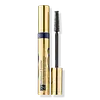Lancôme Hypnôse Drama Instant Full Body Volume Mascara Versus Estée Lauder Sumptuous Extreme Lash Multiplying Volume Mascara
What's inside
What's inside
 Key Ingredients
Key Ingredients

 Benefits
Benefits

 Concerns
Concerns

 Ingredients Side-by-side
Ingredients Side-by-side

Isododecane
EmollientCera Alba
EmollientCopernicia Cerifera Cera
EmollientDisteardimonium Hectorite
StabilisingCI 77499
Cosmetic ColorantWater
Skin ConditioningAllyl Stearate/Va Copolymer
Oryza Sativa Cera
Skin ConditioningParaffin
PerfumingAlcohol Denat.
AntimicrobialPolyvinyl Laurate
Vp/Eicosene Copolymer
Propylene Carbonate
SolventTalc
AbrasiveSynthetic Beeswax
Emulsion StabilisingCandelilla Cera
EmollientPEG-30 Glyceryl Stearate
EmulsifyingPanthenol
Skin ConditioningEthylenediamine/Stearyl Dimer Dilinoleate Copolymer
Skin ConditioningBHT
AntioxidantPentaerythrityl Tetra-Di-T-Butyl Hydroxyhydrocinnamate
AntioxidantMethylparaben
PreservativePropylparaben
PreservativeIsododecane, Cera Alba, Copernicia Cerifera Cera, Disteardimonium Hectorite, CI 77499, Water, Allyl Stearate/Va Copolymer, Oryza Sativa Cera, Paraffin, Alcohol Denat., Polyvinyl Laurate, Vp/Eicosene Copolymer, Propylene Carbonate, Talc, Synthetic Beeswax, Candelilla Cera, PEG-30 Glyceryl Stearate, Panthenol, Ethylenediamine/Stearyl Dimer Dilinoleate Copolymer, BHT, Pentaerythrityl Tetra-Di-T-Butyl Hydroxyhydrocinnamate, Methylparaben, Propylparaben
Water
Skin ConditioningStearic Acid
CleansingMyrica Cerifera Fruit Wax
EmollientSucrose Polybehenate
EmollientPolyisobutene
Polyvinyl Acetate
Emulsion StabilisingParaffin
PerfumingAminomethyl Propanediol
BufferingIsostearic Acid
CleansingSilica
AbrasivePanthenol
Skin ConditioningPantethine
EmollientCopernicia Cerifera Wax
Kaolin
AbrasiveHydroxyethylcellulose
Emulsion StabilisingCholesterol
EmollientHydrogenated Olive Oil
Skin ConditioningPtfe
Vp/Eicosene Copolymer
Olea Europaea Fruit Oil
MaskingOlea Europaea Oil Unsaponifiables
Skin ConditioningSodium Polyacrylate
AbsorbentRosmarinus Officinalis Leaf Extract
AntimicrobialSimethicone
EmollientPolyester-5
Pvp
Emulsion StabilisingCaprylyl Glycol
EmollientHexylene Glycol
EmulsifyingNylon-6
Laureth-4
EmulsifyingPolyethylene Terephthalate
Nylon-66
Synthetic Fluorphlogopite
Chlorphenesin
AntimicrobialPhenoxyethanol
PreservativeCI 77891
Cosmetic ColorantMica
Cosmetic ColorantCI 77491
Cosmetic ColorantCI 77492
Cosmetic ColorantCI 77499
Cosmetic ColorantCI 77266
Cosmetic ColorantCI 77510
Cosmetic ColorantCI 42090
Cosmetic ColorantCI 77007
Cosmetic ColorantCI 19140
Cosmetic ColorantCI 77163
Cosmetic ColorantCI 75470
Cosmetic ColorantCI 77289
Cosmetic ColorantCI 77288
Cosmetic ColorantWater, Stearic Acid, Myrica Cerifera Fruit Wax, Sucrose Polybehenate, Polyisobutene, Polyvinyl Acetate, Paraffin, Aminomethyl Propanediol, Isostearic Acid, Silica, Panthenol, Pantethine, Copernicia Cerifera Wax, Kaolin, Hydroxyethylcellulose, Cholesterol, Hydrogenated Olive Oil, Ptfe, Vp/Eicosene Copolymer, Olea Europaea Fruit Oil, Olea Europaea Oil Unsaponifiables, Sodium Polyacrylate, Rosmarinus Officinalis Leaf Extract, Simethicone, Polyester-5, Pvp, Caprylyl Glycol, Hexylene Glycol, Nylon-6, Laureth-4, Polyethylene Terephthalate, Nylon-66, Synthetic Fluorphlogopite, Chlorphenesin, Phenoxyethanol, CI 77891, Mica, CI 77491, CI 77492, CI 77499, CI 77266, CI 77510, CI 42090, CI 77007, CI 19140, CI 77163, CI 75470, CI 77289, CI 77288
Ingredients Explained
These ingredients are found in both products.
Ingredients higher up in an ingredient list are typically present in a larger amount.
Ci 77499 is also hydrated iron III oxide. It is created from mixing red and black iron oxides. This helps give shades of darkness to a product.
Iron III oxides are classified as inorganic chemicals for coloring.
Panthenol is a common ingredient that helps hydrate and soothe the skin. It is found naturally in our skin and hair.
There are two forms of panthenol: D and L.
D-panthenol is also known as dexpanthenol. Most cosmetics use dexpanthenol or a mixture of D and L-panthenol.
Panthenol is famous due to its ability to go deeper into the skin's layers. Using this ingredient has numerous pros (and no cons):
Like hyaluronic acid, panthenol is a humectant. Humectants are able to bind and hold large amounts of water to keep skin hydrated.
This ingredient works well for wound healing. It works by increasing tissue in the wound and helps close open wounds.
Once oxidized, panthenol converts to pantothenic acid. Panthothenic acid is found in all living cells.
This ingredient is also referred to as pro-vitamin B5.
Learn more about PanthenolParaffin is a solid created from petroleum. The term 'paraffin' can also refer to either
petroleum jelly or mineral oil.
It has natural occlusive properties which can worsen oily skin. Due to its petrolatum base, this ingredient is not fungal-acne safe.
We don't have a description for Vp/Eicosene Copolymer yet.
Water. It's the most common cosmetic ingredient of all. You'll usually see it at the top of ingredient lists, meaning that it makes up the largest part of the product.
So why is it so popular? Water most often acts as a solvent - this means that it helps dissolve other ingredients into the formulation.
You'll also recognize water as that liquid we all need to stay alive. If you see this, drink a glass of water. Stay hydrated!
Learn more about Water